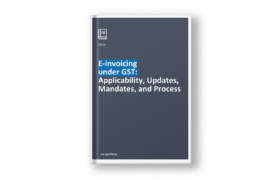With the GST e-invoicing mandate in India overlooking a government-regulated step towards digitization, there are questions pertaining to the implementation, legality, and guidelines that dictate how the e-invoicing process works. For instance, it’s a common misconception that e-invoicing under GST ‘generates’ invoices for the supplier. Instead, it is a platform for supplier-generated invoices to be ‘registered’ on a common unified government portal (Invoice Registration Portal).
Therefore, taxpayers can continue to use their existing Accounting/ERP systems to create invoices and report them to the IRP to be uniquely identified with an Invoice Reference Number (IRN) hash and QR code.
Some of the insights discussed in the eBook include:
- How does e-invoicing under GST work?
- GST e-invoicing applicability in terms of business sectors, zones, types of transactions, and types of documents.
- The complete e-invoicing process with technical and mandated specifications.
- E-invoicing cancellation procedure and re-processing guidelines.
- What information IRN and QR codes hold and why this information is mandatory for inclusion on invoices.
- The mandates surrounding e-way bill generation and how its implementation benefits logistics and supply chain processes.
- E-way bill and e-invoicing format under GST with a detailed schema depicting the mandatory fields required for the generation of IRN, QR code, and E-way bill number.
